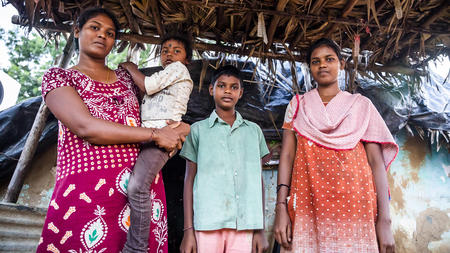Twenty-three-year-old Bharathi was busy running after her five-year-old son when we met her at her home in the Rajagopalapuram village. Her hair was tied up in a bun, revealing her bare neck. She adjusted the dupatta across her shoulders. “I miss my ornaments—my gold ear rings and a necklace,” she said, a little self-conscious. It’s been 10 months since Bharathi had to pawn her gold ornaments to the local moneylender in exchange for some money. “It was an emergency; I needed Rs 48,000 to pay off our medical bills when four of us in the family fell ill,” she said. Water, she said, was the root cause of this problem, not just draining their resources but also adding to their debt.
Illnesses: a common occurrence
Fever, vector-borne diseases like dengue and malaria, typhoid, stomach infections were common in Bharathi’s village in the Chittoor district in Andhra Pradesh. Everyone suffered—children more than others. All the illnesses led back to the same source of infection—stagnant and contaminated water.
“Earlier our main source of water was through government supply. It used to be muddy at times and would come from a pond that was about one and half kilometre away from the village,” Bharathi said. But the water supply was erratic, coming “once in three or five or seven days”. “Once it came after 10 days,” she said. People therefore had no option but to store water in pots and buckets.
This was where trouble would germinate.
“Stagnant water is the perfect breeding ground for mosquito larvae,” Bujamma, the Anganwadi worker in the village said, “This is why dengue and malaria were so common here. But what choice did people have?”
The economics of health
Bharathi, for instance, said that the reason why her five-year-old had frequent episodes of fever and tummy upsets was the “stale, stored water that he had to drink”. “Headache, fever would be so common in the house—my son would have it, my sister, my husband, me,” she said. Last year, the whole family had a serious bout of recurrent illnesses—the price of which Bharathi had to pay with her ornaments. “My 20 grams of gold fetched me Rs 45,000; I added a little from my salary and paid off the medical bills,” she said. “I haven’t been able to recover that money till now.” Bharathi works as an operator in a factory in the nearby Sri City, a business integrated city, and earns a monthly salary of Rs 9,000. Her husband works there as well.
Both Bharathi and Bujamma said that it was common for the village community to borrow money from the local moneylender who takes an interest of 24 per cent. “Most of it is to pay off medical bills.”
Fifty-year-old Poulamma for instance said that her family had to spend Rs 30,000 last year when all the four members in her house—she, her husband, and their two grown-up sons—had typhoid, “most probably by contaminated water”. “Some people in the village had to spend Rs 50,000 (on medical bills). Last year was bad,” she said.
Clean, regular water supply= a new beginning
A few months back, however, the residents of Rajagopalapuram saw a way out of this darkness. WaterAid India and PepsiCo Foundation, with the support of their local partner, Rashtriya Seva Samithi (RASS), dug a borewell in the village and, through a motor and a storage tank, ensured that clean water reached everyone, every day. This changed the whole scene.
“The very first relief was that we no longer needed to store water,” Poulamma said. With no requirement of water storage, the frequency of the common diseases afflicting everyone in the village, particularly the children, came down. “Earlier we would spend Rs 500-1000 every two months on medical expenditures. Plus, spend money on bottled water every time we fall ill. Now all those expenditures have gone,” she said.
Bharathi is happy too. “I fell ill last in June—that’s a very good record!” she laughed, then added after a thought, “I just hope I can get my ornaments back soon now.”


